The boss of one of the world’s biggest banks says the US can still handle two more rate cuts this year
Bryan Moynihan says in an interview says the US economy can absorb two more modest interest rate cuts this year, but has a warning about debt.
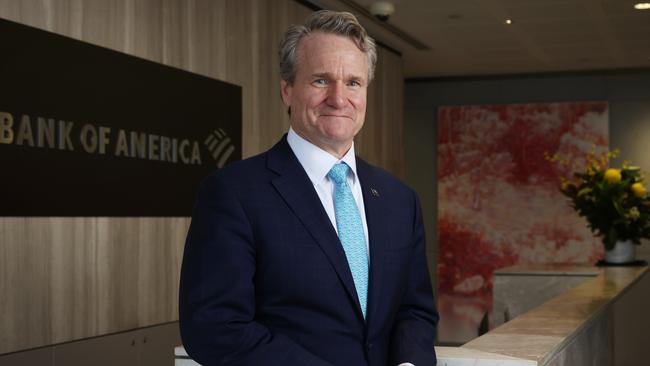
There are few signs that inflation has re-emerged throughout the US, which means the economy can still absorb two more modest interest rate cuts this year, the Bank of America chairman and CEO Brian Moynihan believes.
Speaking to The Australian, Moynihan says: “I don’t think people fear inflation is coming back.”
There were some areas where inflation was “always going to take longer to work through” like housing, rent and insurance. But there are other areas where US consumers are starting to see a big benefit, such as petrol prices and other commodities.
“The glide path for inflation is in the right place,” the banking boss says in an interview at BofA’s Australian headquarters in Sydney.
The US is showing all the signs of a more normal pre-pandemic economy, with consumer spending recovering and jobs and wages growth steady. Although business borrowing remains subdued, he noted.
Moynihan’s comments come amid broader signs the US economy is starting to pick up momentum at a faster rate, led by a consumer rebound. This has started to flow through to money markets with a sell-off in US bonds this week on creeping concerns inflation could re-emerge – particularly if the US Federal Reserve cuts too quickly. Compounding this is the uncertain policy front following next month’s Presidential election, where both Donald Trump and Kamala Harris have their campaigns grounded on a big-spending White House, but few clues on where.
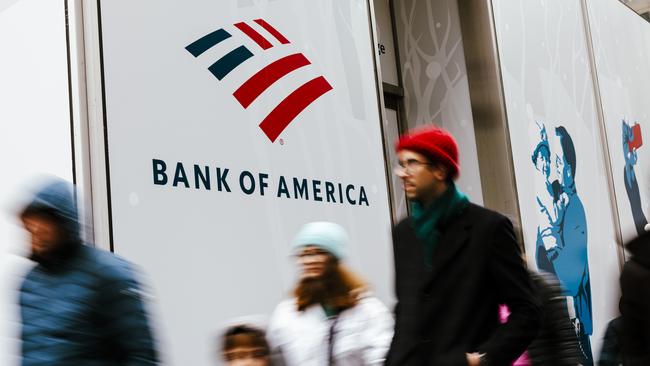
Futures markets have fully priced in at least one more cut by the end of this year, possibly as early as November. Just a few weeks ago confidence was running around two cuts, but this is now starting to be wound back.
Moynihan is still in the two more rate cut camp from the US Fed, although he says the central bank will be “on guard” about inflation and stop if it thinks it has gone too far.
Still, he believes the cuts can be handled by the economy.
“The rate structure in the United States is still very restricted. Inflation is 3 per cent, the Fed Funds rate is at 4.75 per cent. That is a big drag on the economy.”
The BofA boss is visiting Australia as part of the bank’s 60th birthday celebration. During his short visit he hosted a roundtable with a number of business leaders and clients in Sydney, including Macquarie boss Shemara Wikramanayake.
BofA ranks as one of the biggest banks in the world, with a market value of $US325.2bn ($486.5bn). For context that makes it twice the size of Australia’s Commonwealth Bank.
It has one of the biggest branch footprints across the US with nearly 70 million consumer and business customers. It has over US$3 trillion in assets, and employs more than 210,000 globally.
Moynihan says US consumer activity is “healthy” despite concerns about the cost of living and high interest rates. This is starting to recover where there were signs of slowing during the June quarter.
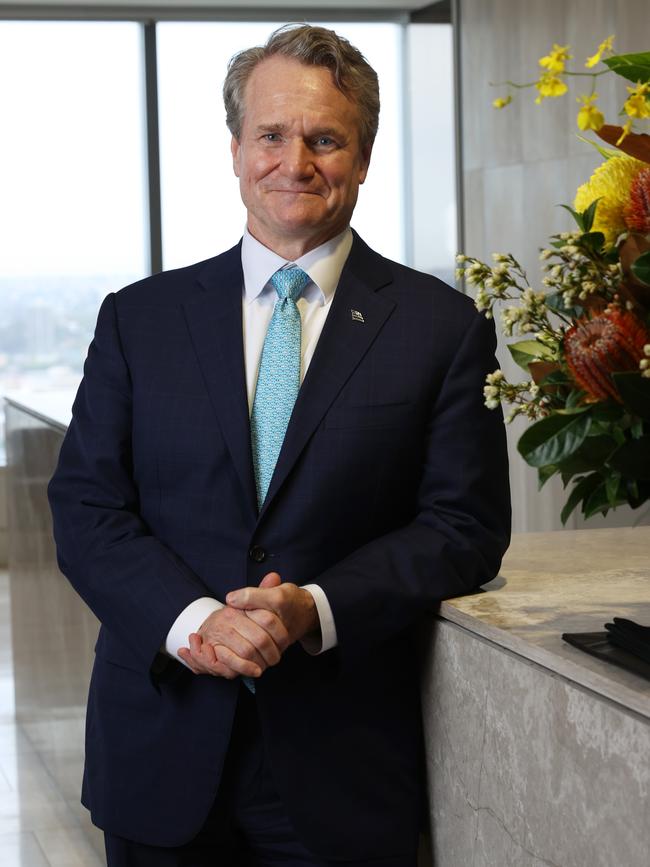
As the biggest main street bank in the US, Moynihan has the best line of sight in terms of activity through the economy, and broadly sees slowing growth and falling inflation. However, he has seen a pick-up in consumer spending in recent months with payments up 4 per cent to 5 per cent for the September quarter, with the trend continuing into October.
“This activity is consistent with how customers are spending money in the 2016 to 2019 time frame, when the economy was growing and inflation was under control.”
Business customers are a little more cautious around spending and investment, given they are more sensitive to higher interest rates. However, the consumer is the one to watch and confidence is the key.
“We’re not a commodities-led economy. We’re not a corporate-led economy, we’re a consumer-led economy. And technical economists often say that doesn’t mean anything. What it means is people spend a lot of money, and then people make stuff for them to buy and that that’s why the US economy keeps going.”
It was BofA’s acquisition of the then struggling Wall Street bank Merrill Lynch for $US50bn at the height of the Global Financial Crisis that turned it into one of the world’s most influential banks.
That emergency deal supercharged BofA’s growth across wealth management and delivered global investment banking to the conservative main street lender.
Indeed, the acquisition created a banking major so vast it could provide branch banking in small town America as well as mergers and acquisition services on a global scale. Five years ago, it rebranded its retail wealth management and private banking business as “Merrill” and ran investment banking under the flagship BofA brand.
Although it now controls one of Wall Street’s most-storeyed institutions, at its core the Charlotte, North Carolina-headquartered BofA remains a highly-conservative institution that leans into its southern heritage.
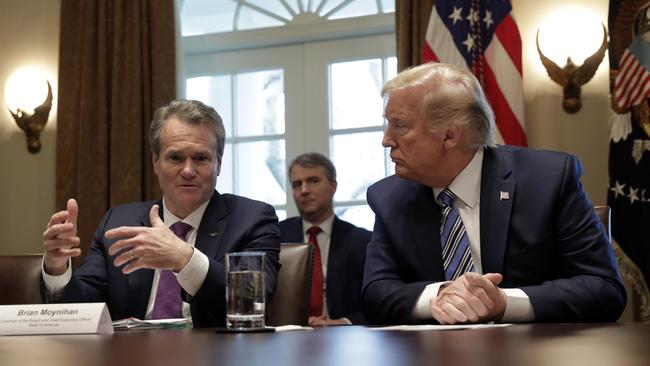
Moynihan, a one-time corporate lawyer, worked his way through BofA’s businesses, including consumer and small business banking. He was appointed to head up Merrill Lynch shortly after BofA took control in 2008, and was named group-wide CEO in 2010.
Through his tenure, Moynihan has talked up the need to drive organic growth by getting existing operations working more efficiently. He has put the flurry of deal-making of his predecessors behind the bank by resisting acquisitions.
Whether its retail banking or investment banking, Moynihan says successful businesses are built around serving clients regardless of the market or country.
Today BofA is delivering smoother and predictable profits, and in the past decade it has generated more than $US200bn in earnings. Costs control too has been a big focus. He points out the bank is running an annual cost base today in dollar terms as it was running in 2016 – even before taking into account inflation.
His strategy is built around “responsible growth” a phrase that has helped deliver a lower-risk BofA in the years following the GFC. The bank was one of the biggest beneficiaries during last year’s Silicon Valley Bank-led crisis, with tens of billions in deposits flowing to Moynihan’s bank.
Australia represents BofA’s fifth-biggest market outside the US, with exposure of $US21bn in loans and commitments. This is just behind France at $US24bn and Canada at $US28bn.
The US election is in two weeks and Moynihan says the outcome will be close, just as much as hard fought. Whatever the outcome it is important to keep perspective.
“We’ve been through tough elections. That one in 1800 was really tough, and they wrote a wonderful plays about it,” he says in a nod to the popular Broadway musical Hamilton.
“So the idea is in the US we have elections every four years, they happen, and we go on.”
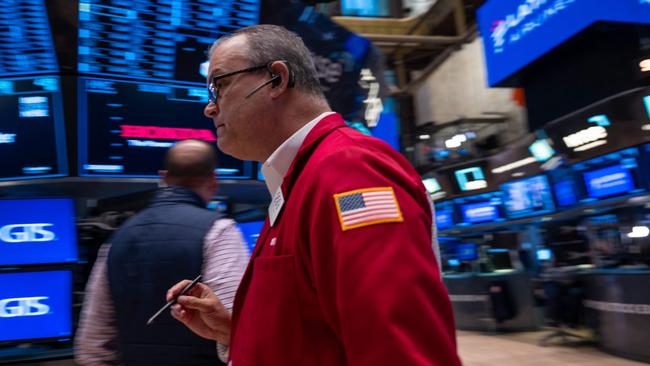
BofA’s interests are in the economy being in good shape “and everything we see it is”, he says, but the outcome of the election will be more nuanced than what most people think.
“The outcome (of the election) is going to be how they affect the economy, not who the candidate is. That outcome is going to be based on the policies, which we don’t know what the policy is going to be yet.
“Policy has two things: ‘what I want to do’ and ‘what I can do’. And ‘what I want to do’ is a number of things. ‘What I can do’ with the House and Senate is a different story.
“If it’s a very narrow mandate across the board, that constrains the activity. And so the United States has a tendency to work towards the middle once they get through this session of the election.”
Still he has a warning for both Harris and Trump which, is to start dealing with the ballooning US debt. With public debt running at more than the size of the US economy this is becoming a big risk.
“The US operating deficit last year was $US1.8 trillion – that’s bigger than the Australian economy. We can’t go on like that,” he says.
“They don’t need to assault (the debt) overnight. They just need to work on revenue, work on spending and dedicate to actually shrinking … as opposed to something else that can’t go on. While its not an immediate risk, the pressure is building over time.
“Your country has a great position below 50 per cent debt to GDP – that’s a good place to be after the pandemic. We’re not. We need to stop the growth of the debt in our economy as a percentage. Work it back down and let the economy grow around it again.”






To join the conversation, please log in. Don't have an account? Register
Join the conversation, you are commenting as Logout